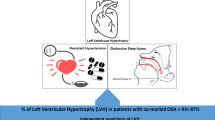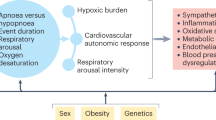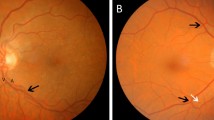Abstract
Subclinical abnormalities in cardiac and vascular structure reflect the adverse effects triggered by a variety of risk factors on the cardiovascular (CV) system thereby representing an intermediate step in the cardiovascular continuum; such alterations are recognized as reliable markers of increased cardiovascular risk in different clinical settings including obstructive sleep apnea (OSA). The mechanisms underlying subclinical organ damage (OD) in the OSA setting are multifactorial. Hypoxemia and hypercapnia, induced by repeated collapses of upper airways, have been suggested to trigger a cascade of events such as activation of the sympathetic tone, renin–angiotensin–aldosterone system leading to endothelial dysfunction, vasoconstriction, myocardial and vascular remodeling, and hypertension. Furthermore, coexisting non-haemodynamic alterations such as increased oxidative stress, release of inflammatory substances, enhanced lipolysis and insulin resistance have been reported to play a role in the pathogenesis of both cardiac and extra-cardiac OD. In this article we reviewed available evidence on the association between OSA and subclinical cardiac (i.e., left and right ventricular hypertrophy, left atrial dilatation) and extra-cardiac organ damage (i.e., carotid atherosclerosis, arterial stiffness, microvascular retinal changes, and microalbuminuria). This association is apparently stronger for cardiac and carotid subclinical damage than for other markers (i.e., arterial stiffness and retinal changes) and mostly evident in the setting of severe OSA.
This is a preview of subscription content, access via your institution
Access options
Subscribe to this journal
Receive 12 digital issues and online access to articles
$119.00 per year
only $9.92 per issue
Buy this article
- Purchase on Springer Link
- Instant access to full article PDF
Prices may be subject to local taxes which are calculated during checkout

Similar content being viewed by others
References
Dredla BK, Castillo PR. Cardiovascular consequences of obstructive sleep apnea. Curr Cardiol Rep. 2019;21:137.
Lacedonia D, Carpagnano GE, Patricelli G, Carone M, Gallo C, Caccavo I, et al. Prevalence of comorbidities in patients with obstructive sleep apnea syndrome, overlap syndrome and obesity hypoventilation syndrome. Clin Respir J. 2018;12:1905–11.
Seravalle G, Mancia G, Grassi G. Sympathetic nervous system, sleep, and hypertension. Curr Hypertens Rep. 2018;20:74.
Grassi G, Facchini A, Trevano FQ, Dell’Oro R, Arenare F, Tana F, et al. Obstructive sleep apnea-dependent and -independent adrenergic activation in obesity. Hypertension. 2005;46:321–5.
Khayat RN, Varadharaj S, Porter K, Sow A, Jarjoura D, Gavrilin MA, et al. Angiotensin receptor expression and vascular endothelial dysfunction in obstructive sleep apnea. Am J Hypertens. 2018;31:355–61.
Schlatzer C, Schwarz EI, Sievi NA, Clarenbach CF, Gaisl T, Haegeli LM, et al. Intrathoracic pressure swings induced by simulated obstructive sleep apnoea promote arrhythmias in paroxysmal atrial fibrillation. Europace. 2016;18:64–70.
Isobe Y, Nakatsumi Y, Sugiyama Y, Hamaoka T, Murai H, Takamura M, et al. Severity indices for obstructive sleep apnea syndrome reflecting glycemic control or insulin resistance. Intern Med. 2019;58:3227–34.
Williams B, Mancia G, Spiering W, Agabiti Rosei E, Azizi M, Burnier M, et al. 2018 ESC/ESH Guidelines for the management of arterial hypertension. The Task Force for the management of arterial hypertension of the European Society of Cardiology and the European Society of Hypertension. J Hypertens. 2018;36:2284–309.
Park JS, Shin JS, Lee YH, Seo KW, Choi BJ, Choi SY, et al. Prognostic impact of left ventricular mass change in patients with ST-elevation myocardial infarction. Medicine. 2018;97:e9748.
Salvetti M, Muiesan ML, Paini A, Monteduro C, Agabiti-Rosei C, Aggiusti C, et al. Left ventricular hypertrophy and renal dysfunction during antihypertensive treatment adversely affect cardiovascular prognosis in hypertensive patients. J Hypertens. 2012;30:411–20.
Catena C, Colussi GL, Valeri M, Sechi LA. Association of aldosterone with left ventricular mass: interaction with plasma fibrinogen levels. Am J Hypertens. 2012;26:111–7.
Lazzeroni D, Rimoldi O, Camici PG. From left ventricular hypertrophy to dysfunction and failure. Circ J. 2016;80:555–64.
Patil DR, Sarber KM. Sleep apnea treatment considerations in patients with comorbidities. Otolaryngol Clin North Am. 2020;S0030-6665:30003–7.
Hedner J, Ejnell H, Caidahl K. Left ventricular hypertrophy independent of hypertension in patients with obstructive sleep apnoea. J Hypertens. 1990;8:941–6.
Shivalkar B, Van de Heyning C, Kerremans M, Rinkevich D, Verbraecken J, De Backer W, et al. Obstructive sleep apnea syndrome: more insights on structural and functional cardiac alterations, and the effects of treatment with continuous positive airway pressure. J Am Coll Cardiol. 2006;47:1433–9.
Myslinski W, Duchna HW, Rasche K, Dichmann M, Mosiewicz J, Schultze-Werninghaus G. Left ventricular geometry in patients with obstructive sleep apnea coexisting with treated systemic hypertension. Respiration. 2007;74:176–83.
Cioffi G, Russo TE, Stefenelli C, Selmi A, Furlanello F, Cramariuc D, et al. Severe obstructive sleep apnea elicits concentric left ventricular geometry. J Hypertens. 2010;28:1074–82.
Cioffi G, Russo TE, Selmi A, Stefenelli C, Furlanello F. Analysis of left ventricular systolic function by midwall mechanics in patients with obstructive sleep apnoea. Eur J Echocardiogr. 2011;12:61–8.
Wachter R, Lüthje L, Klemmstein D, Lüers C, Stahrenberg R, Edelmann F, et al. Impact of obstructive sleep apnoea on diastolic function. Eur Respir J. 2013;41:376–83.
Sun Y, Yuan H, Zhao MQ, Wang Y, Xia M, Li YZ. Cardiac structural and functional changes in old elderly patients with obstructive sleep apnoea-hypopnoea syndrome. J Int Med Res. 2014;42:395–404.
Glantz H, Thunström E, Johansson MC, Wallentin Guron C, Uzel H, Ejdebäck J, et al. Obstructive sleep apnea is independently associated with worse diastolic function in coronary artery disease. Sleep Med. 2015;16:160–7.
Lisi E, Faini A, Bilo G, Lonati LM, Revera M, Salerno S, et al. Diastolic dysfunction in controlled hypertensive patients with mild-moderate obstructive sleep apnea. Int J Cardiol. 2015;187:686–92.
Usui Y, Takata Y, Inoue Y, Tomiyama H, Kurohane S, Hashimura Y, et al. Severe obstructive sleep apnea impairs left ventricular diastolic function in non-obese men. Sleep Med. 2013;14:155–9.
Imai Y, Tanaka N, Usui Y, Takahashi N, Kurohane S, Takei Y, et al. Severe obstructive sleep apnea increases left atrial volume independently of left ventricular diastolic impairment. Sleep Breath. 2015;19:1249–55.
Yamaguchi T, Takata Y, Usui Y, Asanuma R, Nishihata Y, Kato K, et al. Nocturnal intermittent hypoxia is associated with left ventricular hypertrophy in middle-aged men with hypertension and obstructive sleep apnea. Am J Hypertens. 2016;29:372–9.
Sekizuka H, Osada N, Akashi YJ. Impact of obstructive sleep apnea and hypertension on left ventricular hypertrophy in Japanese patients. Hypertens Res. 2017;40:477–82.
Chami HA, Devereux RB, Gottdiener JS, Mehra R, Roman MJ, Benjamin EJ, et al. Left ventricular morphology and systolic function in sleep-disordered breathing: the Sleep Heart Health Study. Circulation. 2008;117:2599–607.
Avelar E, Cloward TV, Walker JM, Farney RJ, Strong M, Pendleton RC, et al. Left ventricular hypertrophy in severe obesity: interactions among blood pressure, nocturnal hypoxemia, and body mass. Hypertension. 2007;49:34–9.
Muxfeldt ES, Margallo VS, Guimarães GM, Salles GF. Prevalence and associated factors of obstructive sleep apnea in patients with resistant hypertension. Am J Hypertens. 2014;27:1069–78.
Pujante P, Abreu C, Moreno J, Barrero EA, Azcarate P, Campo A, et al. Obstructive sleep apnea severity is associated with left ventricular mass independent of other cardiovascular risk factors in morbid obesity. J Clin Sleep Med. 2013;9:1165–71.
Dobrowolski P, Klisiewicz A, Prejbisz A, Florczak E, Rybicka J, Bieleń P, et al. Factors associated with diastolic dysfunction in patients with resistant hypertension: resist-POL study. Am J Hypertens. 2015;28:307–11.
Bauters FA, Hertegonne KB, De Buyzere M, Joos GF, Chirinos JA, Rietzschel ER. Phenotype and risk burden of sleep apnea: a population-based cohort study. Hypertension. 2019;74:1052–62.
Yu L, Li H, Liu X, Fan J, Zhu Q, Li J, et al. Left ventricular remodeling and dysfunction in obstructive sleep apnea: systematic review and meta-analysis. Herz. 2019. PMID: 31555891.
Cuspidi C, Tadic M, Sala C, Gherbesi E, Grassi G, Mancia G. Targeting concentric left ventricular hypertrophy in obstructive sleep apnea syndrome. A meta-analysis of echocardiographic studies. Am J Hypertens. 2019;33:310–5.
Cuspidi C, Tadic M, Sala C, Gherbesi E, Grassi G, Mancia G. Obstructive sleep apnoea syndrome and left ventricular hypertrophy: a meta-analysis of echocardiographic studies. J Hypertens. 2020;38:1640–9.3.
Bombelli M, Facchetti R, Cuspidi C, Villa P, Dozio D, Brambilla G, et al. Prognostic significance of left atrial enlargement in a general population: results of the PAMELA study. Hypertension. 2014;64:1205–11.
Tsioufis C, Stougiannos P, Taxiarchou E, Skiadas I, Chatzis D, Thomopoulos C, et al. The interplay between haemodinamic load, brain natriuretic peptide and left atrial size in the early stages of essential hypertension. J Hypertens. 2006;24:965–72.
Romero-Corral A, Somers VK, Pellikka KA, Olson EJ, Bailey KR, Korinek J, et al. Decreased right and left ventricular myocardial performance in obstructive sleep apnea. Chest. 2007;132:1863–70.
Altekin RE, Karakas MS, Yanikoglu A, Ozel D, Ozbudak O, Demir I, et al. Determination of right ventricular dysfunction using the speckle tracking echocardiography method in patients with obstructive sleep apnea. Cardiol J. 2012;19:130–9.
Varghese MJ, Sharma G, Shukla G, Seth S, Sundeep S, Gupta A, et al. Longitudinal ventricular systolic dysfunction in patients with very severe obstructive sleep apnea: a case control study using speckle tracking imaging. Indian Heart J. 2017;69:305–10.
Hjalm HH, Fu F, Hansson PO, Zhong Y, Caidahl K, Mandalenakis Z, et al. Association between left atrial enlargement and obstructive sleep apnea in a general population of 71-year-old men. J Sleep Res. 2018;27:254–60.
Mattaliano P, Lombardi C, Sangalli D, Faini A, Corrà B, Adobbati L, et al. Impact of obstructive sleep apnea on cardiac organ damage in patients with acute ischemic stroke. J Hypertens. 2018;36:1351–9.
Cuspidi C, Sala C, Muiesan ML, De Luca N, Schillaci G. Working Group on Heart, Hypertension of the Italian Society of Hypertension. Right ventricular hypertrophy in systemic hypertension: an updated review of clinical studies. J Hypertens. 2013;31:858–65.
Vitarelli A, Terzano C, Saponara M, Gaudio C, Mangieri E, Capotosto L, et al. Assessment of right ventricular function in obstructive sleep apnea syndrome and effects of continuous positive airway pressure therapy: a pilot study. Can J Cardiol. 2015;31:823–31.
Maripov A, Mamazhakypov A, Sartmyrzaeva M, Akunov A, Muratali K, Duishobaev M, et al. Right ventricular remodeling and dysfunction in obstructive sleep apnea: a systematic review of the literature and meta-analysis. Can Respir J. 2017;2017:1587865.
Paraskevas KI, Sillesen HH. Carotid atherosclerosis markers and adverse cardiovascular events. Int J Cardiol. 2020;15:178.
Naqvi TZ, Lee MS. Carotid intima-media thickness and plaque in cardiovascular risk assessment. JACC Cardiovasc Imaging. 2014;7:1025–38.
Kokubo Y, Watanabe M, Higashiyama A, Nakao YM, Nakamura F, Miyamoto Y. Impact of intima-media thickness progression in the common carotid arteries on the risk of incident cardiovascular disease in the Suita Study. J Am Heart Assoc. 2018;7:e007720.
Drager LF, Bortolotto LA, Krieger EM, Lorenzi-Filho G. Additive effects of obstructive sleep apnea and hypertension on early markers of carotid atherosclerosis. Hypertension. 2009;53:64–9.
Steiropoulos P, Bogiatzi C, Archontogeorgis K, Nena E, Xanthoudaki M, Boglou P, et al. Is there evidence of early vascular disease in patients with obstructive sleep apnoea without known comorbidities? Preliminary findings. Open Cardiovasc Med J. 2013;7:61–8.
Ciccone MM, Scicchitano P, Zito A, Cortese F, Boninfante B, Falcone VA, et al. Correlation between inflammatory markers of atherosclerosis and carotid intima-media thickness in obstructive sleep apnea. Molecules. 2014;19:1651–62.
Gunnarsson SI, Peppard PE, Korcarz CE, Barnet JH, Aeschlimann SE, Hagen EW, et al. Obstructive sleep apnea is associated with future subclinical carotid artery disease: thirteen-year follow-up from the Wisconsin Sleep Cohort. Arterioscler Thromb Vasc Biol. 2014;34:2338–42.
Nadeem R, Harvey M, Singh M, Khan AA, Albustani M, Baessler A, et al. Patients with obstructive sleep apnea display increased carotid intima media: a meta-analysis. Int J Vasc Med. 2013;2013:839582.
Zhou M, Guo B, Wang Y, Yan D, Lin C, Shi Z. The association between obstructive sleep apnea and carotid intima-media thickness: a systematic review and meta-analysis. Angiology. 2017;68:575–83.
Kim J, Mohler ER, Keenan BT, Maislin D, Arnardottir E, Gislason T, et al. Carotid artery wall thickness in obese and nonobese adults with obstructive sleep apnea before and following positive airway pressure treatment. Sleep. 2017;40:1–10.
Sarioglu N, Demirpolat G, Erel F, Kose M. Which is the ideal marker for early atherosclerosis in obstructive sleep apnea (OSA)—carotid intima-media thickness or mean platelet volume? Med Sci Monit. 2017;23:1674–81.
Kong D, Qin Z, Wang W, Kang J. Effect of obstructive sleep apnea on carotid artery intima media thickness related to inflammation. Clin Invest Med. 2017;40:E25–33.
Chang YT, Lin HC, Chang WN, Tsai NW, Huang CG, Wang HC, et al. Impact of inflammation and oxidative stress on carotid intima-media thickness in sleep apnea patients without metabolic syndrome. J Sleep Res. 2017;26:151–8.
Trojova I, Kozarova M, Petrasova D, Malachovska Z, Paranicova I, Joppa P, et al. Circulating lipopolysaccharide-binding protein and carotid intima-media thickness in obstructive sleep apnea. Physiol Res. 2018;67:69–78.
Nahorecki A, Postrzech-Adamczyk K, Święcicka-Klama A, Skomro R, Szuba A. Prevalence of sleep apnea in patients with carotid artery stenosis. Adv Exp Med Biol. 2019;1211:69–75.
Chang TI, Lee UK, Zeidler MR, Liu SY, Polanco JC, Friedlander AH. Severity of obstructive sleep apnea is positively associated with the presence of carotid artery atheromas. J Oral Maxillofac Surg. 2019;77:93–9.
Deeb R, Smeds MR, Bath J, Peterson E, Roberts M, Beckman N, et al. Snoring and carotid artery disease: a new risk factor emerges. Laryngoscope. 2019;129:265–8.
Song F, Zou J, Song Z, Xu H, Qian Y, Zhu H, et al. Association of adipocytokines with carotid intima media thickness and arterial stiffness in obstructive sleep apnea patients. Front Endocrinol. 2020;11:177.
Deol R, Lee KA, Kanaya AM, Kandula NR. Obstructive sleep apnea risk and subclinical atherosclerosis in South Asians living in the United States. Sleep Health. 2020;6:124–30.
Kim ED, Ballew SH, Tanaka H, Heiss G, Coresh J, Matsushita K. Short-term prognostic impact of arterial stiffness in older adults without prevalent cardiovascular disease. Hypertension. 2019;74:1373–82.
Drager LF, Bortolotto LA, Figueiredo AC, Caldin Silva B, Krieger EM, et al. Obstructive sleep apnea, hypertension, and their interaction on arterial stiffness and heart remodeling. Chest. 2007;131:1379–86.
Jenner R, Fatureto-Borges F, Costa-Hong V, Lopes HF, Teixeira SH, Marum E, et al. Association of obstructive sleep apnea with arterial stiffness and nondipping blood pressure in patients with hypertension. J Clin Hypertens. 2017;19:910–8.
Kim T, Lee CS, Lee SD, Kang SH, Han JW, Malhotra A, et al. Impacts of comorbidities on the association between arterial stiffness and obstructive sleep apnea in the elderly. Respiration. 2015;89:304–11.
Kim J, Lee SK, Yoon DW, Shin C. Obstructive sleep apnoea is associated with progression of arterial stiffness independent of obesity in participants without hypertension: a KoGES Prospective Cohort Study. Sci Rep. 2018;8:8152.
Joyeux-Faure M, Tamisier R, Borel JC, Millasseau S, Galerneau LM, Destors M, et al. Contribution of obstructive sleep apnoea to arterial stiffness: a meta-analysis using individual patient data. Thorax. 2018;73:1146–51.
Kwon Y, Logan J, Redline S, Duprez D, Jacobs DR Jr, Ouyang P, et al. Obstructive sleep apnea and structural/functional properties of the thoracic ascending aorta: The Multi-Ethnic Study of Atherosclerosis (MESA). Cardiology. 2019;142:180–8.
Masaidi M, Cuspidi C, Giudici V, Negri F, Sala C, Zanchetti A, et al. Is retinal arteriolar-venular ratio associated with cardiac and extracardiac organ damage in essential hypertension? J Hypertens. 2009;27:1277–83.
Boland LL, Shahar E, Wong TY, Klein R, Punjabi N, Robbins JA, et al. Sleep-disordered breathing is not associated with the presence of retinal microvascular abnormalities: the Sleep Heart Health Study. Sleep. 2004;27:467–73.
Shankar A, Peppard PE, Young T, Klein BE, Klein R, Nieto FJ. Sleep-disordered breathing and retinal microvascular diameter. Atherosclerosis. 2013;226:124–8.
Chew M, Xie J, Klein R, Klein B, Cotch MF, Redline S, et al. Sleep apnea and retinal signs in cardiovascular disease: the Multi-Ethnic Study of Atherosclerosis. Sleep Breath. 2016;20:15–23.
Lin GM, Redline S, Klein R, Colangelo LA, Cotch MF, Wong TY, et al. Sex-specific association of obstructive sleep apnea with retinal microvascular signs: The Multi-Ethnic Study of Atherosclerosis. J Am Heart Assoc. 2016;5:e00359.
Faulx MD, Storfer-Isser A, Kirchner HL, Jenny NS, Tracy RP, Redline S. Obstructive sleep apnea is associated with increased urinary albumin excretion. Sleep. 2007;30:923–9.
Ursavas A, Karadag M, Gullulu M, Demirdogen E, Coskun F, Onart S, et al. Low-grade urinary albumin excretion in normotensive/non-diabetic obstructive sleep apnea patients. Sleep Breath. 2008;12:217–22.
Tsioufis C, Thomopoulos C, Dimitriadis K, Amfilochiou A, Tsiachris D, Selima M, et al. Association of obstructive sleep apnea with urinary albumin excretion in essential hypertension: a cross-sectional study. Am J Kidney Dis. 2008;52:285–93.
Prejbisz A, Florczak E, Pregowska-Chwala B, Klisiewicz A, Kusmierczyk-Droszcz B, Zielinski T, et al. Relationship between obstructive sleep apnea and markers of cardiovascular alterations in never-treated hypertensive patients. Hypertens Res. 2014;37:573–9.
Bulcun E, Ekici M, Ekici A, Cimen DA, Kisa U. Microalbuminuria in obstructive sleep apnea syndrome. Sleep Breath. 2015;19:1191–7.
Archontogeorgis K, Nena E, Tsigalou C, Voulgaris A, Xanthoudaki M, Froudarakis M, et al. Cystatin C levels in middle-aged patients with obstructive sleep apnea syndrome. Pulm Med. 2016;2016:8081723.
Corral J, Mogollon MV, Sánchez-Quiroga MÁ, Gómez de Terreros J, Romero A, Caballero C, et al. Spanish Sleep Network. Echocardiographic changes with non-invasive ventilation and CPAP in obesity hypoventilation syndrome. Thorax. 2018;73:361–8.
Chen LD, Lin L, Lin XJ, Ou YW, Wu Z, Ye YM, et al. Effect of continuous positive airway pressure on carotid intima-media thickness in patients with obstructive sleep apnea: a meta-analysis. PLoS ONE. 2017;12:e0184293.
Jain S, Gurubhagavatula I, Townsend R, Kuna ST, Teff K, Wadden TA, et al. Effect of CPAP, weight loss, or CPAP plus weight loss on central hemodynamics and arterial stiffness. Hypertension. 2017;70:1283–90.
Author information
Authors and Affiliations
Corresponding author
Ethics declarations
Conflict of interest
The authors declare that they have no conflict of interest.
Additional information
Publisher’s note Springer Nature remains neutral with regard to jurisdictional claims in published maps and institutional affiliations.
Rights and permissions
About this article
Cite this article
Cuspidi, C., Tadic, M., Gherbesi, E. et al. Targeting subclinical organ damage in obstructive sleep apnea: a narrative review. J Hum Hypertens 35, 26–36 (2021). https://doi.org/10.1038/s41371-020-00397-0
Received:
Revised:
Accepted:
Published:
Issue Date:
DOI: https://doi.org/10.1038/s41371-020-00397-0
This article is cited by
-
Obstructive sleep apnea and hypertension-mediated organ damage in nonresistant and resistant hypertension
Hypertension Research (2023)
-
Sleep Apnea and Hypertension
High Blood Pressure & Cardiovascular Prevention (2022)



